Opinion & Analysis
Korea’s answer to help grow the game

When the golfing world was first introduced to Mark Broadie’s Strokes Gained Index (SGI) in 2011, it forever changed the way we look at the game. In direct contrast to legendary Bobby Locke’s iconic phrase “drive for show, putt for dough,” the new method showed that driving the ball well was actually the bigger factor in lowering scores.
At first, I recall thinking that it couldn’t be right. After all, the longest drive and the shortest putt each count the same one stroke, right? But then again, where are you more likely to make a birdie from if your ball is 50 yards and 150 yards from the pin, respectively?

Should the new saying be “Putt for show, Drive for dough?”
Even before Broadie’s method showed the advantages of longer drives, nearly all club and ball manufacturers have been focused on marketing distance. In response, many golf courses tried to lengthen the course to keep the game challenging. But no matter how long golf courses became, long bombers like Bryson and Dustin continued to make short work of them reaching “monstrous” par 5s in two with an 8- iron. It was only a matter of time before golf’s governing bodies declared that things had gone too far.
- Related: Golf in Korea during COVID-19
I understand where the USGA is coming from. But surely there are other ways to make professional golf more challenging than limiting golf ball distance for everyone. After all, why penalize average Joes like me who can barely drive 250? Instead, let’s make the course set up more difficult for professional tournaments and let the rest of us continue our valiant struggle with all the help we can get.
With all the heated online arguments for and against USGA’s stance on distance, however, I found it odd that it has never been an issue here in Korea. In fact, whenever I tried to discuss the topic and how it's dividing golfers in the West, no one here seemed to bat an eye. I too soon came to dismiss it as a non-issue, but after subconsciously mulling about it for a while, I came up with an interesting theory.
Could it be that the courses here are already hard enough without having to add extra sandbags around our ankles?
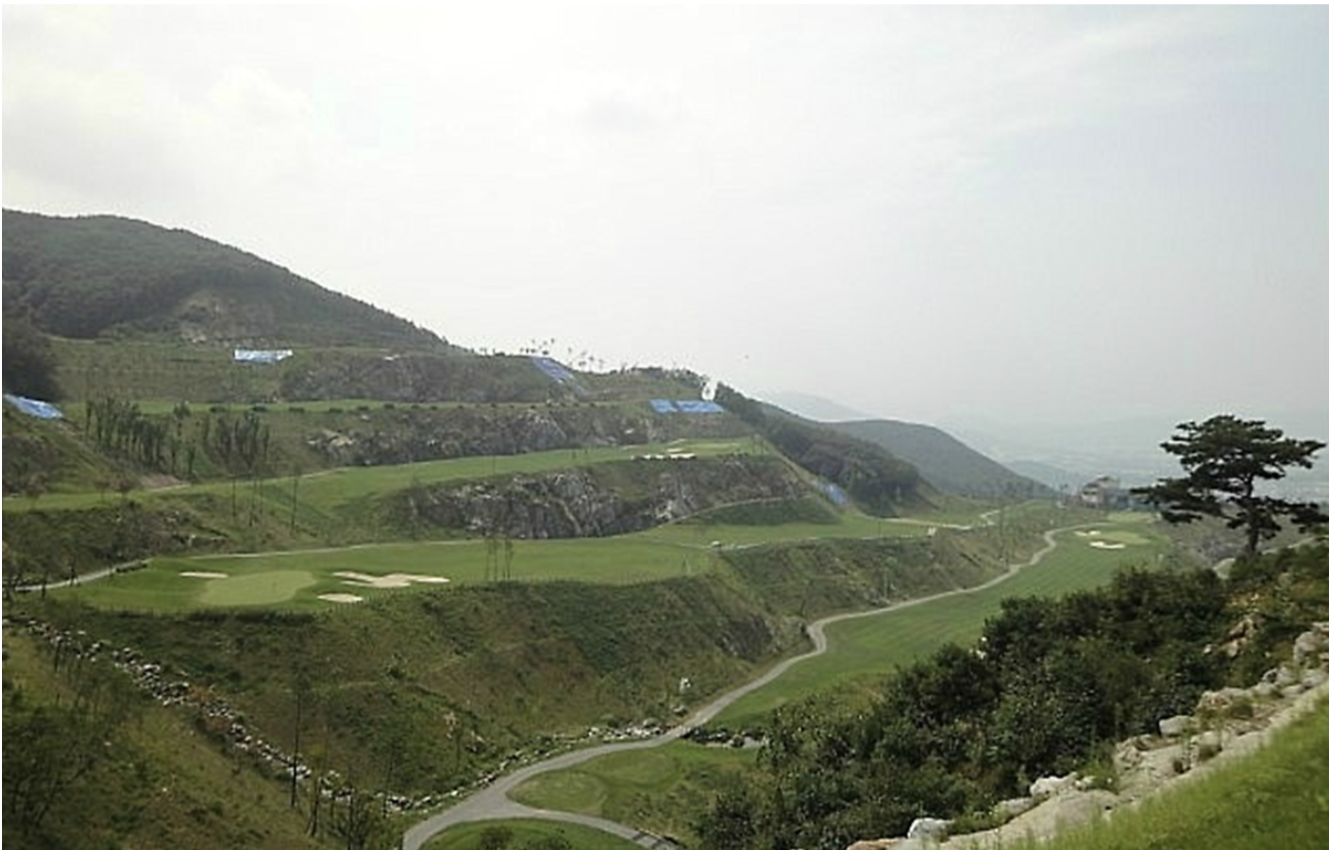
Flat land for building a golf course is rare in Korea
To be sure, I’m not trying to compare Korean courses to beasts like Bethpage Black or Whistling straits. However, it is my contention that most Korean courses have very narrow fairways and an over-abundance of penalty areas in comparison to their Western counterparts. As such, Korean courses support my claim that difficult setups can make the game plenty challenging without limiting equipment distance. Plus, some of the course features and local rules here also act to help grow the game by speeding up play considerably.
Size Matters
To give you some perspective on size, South Korea is a small peninsula about the size of Indiana with mountains covering 70 percent of the country. As a result, the majority of 550+ golf courses here are carved out on top or steep sides of mountains. A typical golf hole here features a hill along one side of the hole and a steep drop-off on the other side. So if a tee shot happens to stray a little off the narrow fairway, the ball is usually declared to be out of bounds or lost.
When I first began playing here in 2001, my first impression was that the courses seemed relatively short and easy. Back in Canada, if a tee shot strays onto the adjacent hole or under a tree, it would simply make for a fun and challenging attempt to scramble for par, right? Nope. Not here. Uh-uh. With almost every hole lined on both sides with OB or hazard stakes, I realized quickly that golf here required a very different approach than what I was used to.

Most of Korea’s 550+ golf courses are carved on top or sides of mountains.
At first, there seemed to be no reason or rhyme as to why the courses had so many penalty areas. In particular, what frustrated me most was having an easy wedge over relatively short trees from an adjacent hole; only to be told it was out of bounds. What good is the ability to pull off amazing Seve-esque recovery shots if I’m not even given a chance to attempt them in the first place?
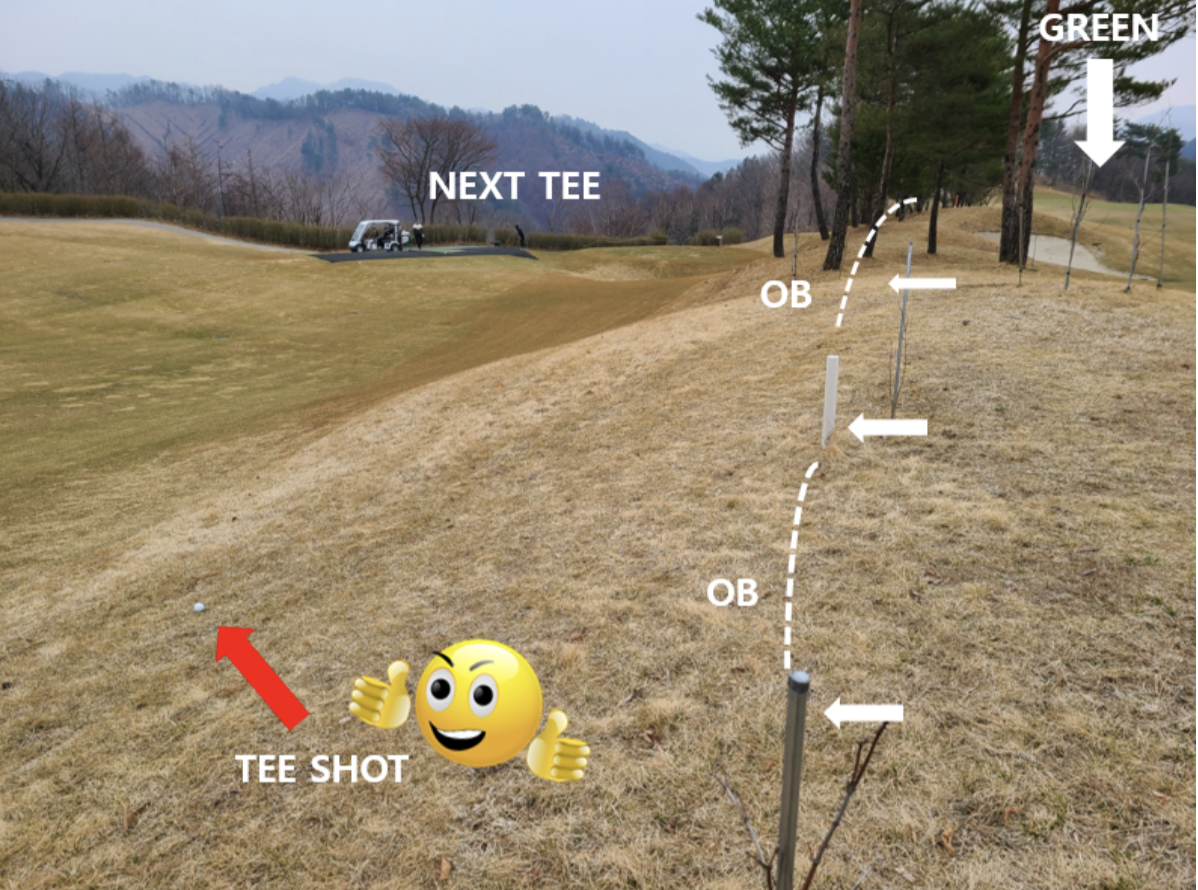
Easy 9 iron to the green? Nope. OB for D-bogey or worse.
Inevitably, I soon developed a severe case of the driver yips in trying to keep my ball in play. No matter how I tried, every round would have at least two or three balls out of bounds. My handicap quickly grew from being a toddler to the legal drinking age, and my foursome began to doubt I had ever broken 80 before. Likewise, my preference for long-distance quickly took a backseat in favor of accurate shot-making.
To be sure, I’m not suggesting a dozen new penalty areas be added or your golf courses are built on the sides of mountains. I’m just saying that before any definitive decision is made on the equipment side of golf, I hope the powers that be can first explore diverse course setups at iconic tournament courses to challenge the best players in the world. After all, there are so many more amateur golfers than professionals, and we certainly need all the help we can get.

Just your typical tee shot with 90 meter drop, OB on both sides to a sloping fairway. No pressure.
Course setup to grow the game?
Aside from an abundance of OB stakes, Korean courses also have several features and local rules which may baffle newcomers. Even though some of them may not be welcomed in all parts of the world, and are certainly not practiced for pro tournament play here, they have undeniably helped the game grow in Korea by speeding up play immensely.

OB tees to save time and ego.
Your home course probably has a drop area on par 3s where hazards come into play. The same applies here but with one big difference in that, we also have a designated drop area for par 4s and par 5s. You see, when a tee shot’s fate is in question, amateur golfers are urged to play from a special set of tees 220~250 yards ahead. So, rather than playing a provisional ball, the golfer would be playing their 3rd or 4th shot from these forward tees, depending on whether the ball landed in a
hazard or out of bounds.
Although it took a bit of getting used to, I have found this common local rule to help in two ways here. One, it speeds up the pace of play considerably; and two, it helps to preserve the sanity of golfers from having to re-tee with the potential to hit multiple balls out of bounds.
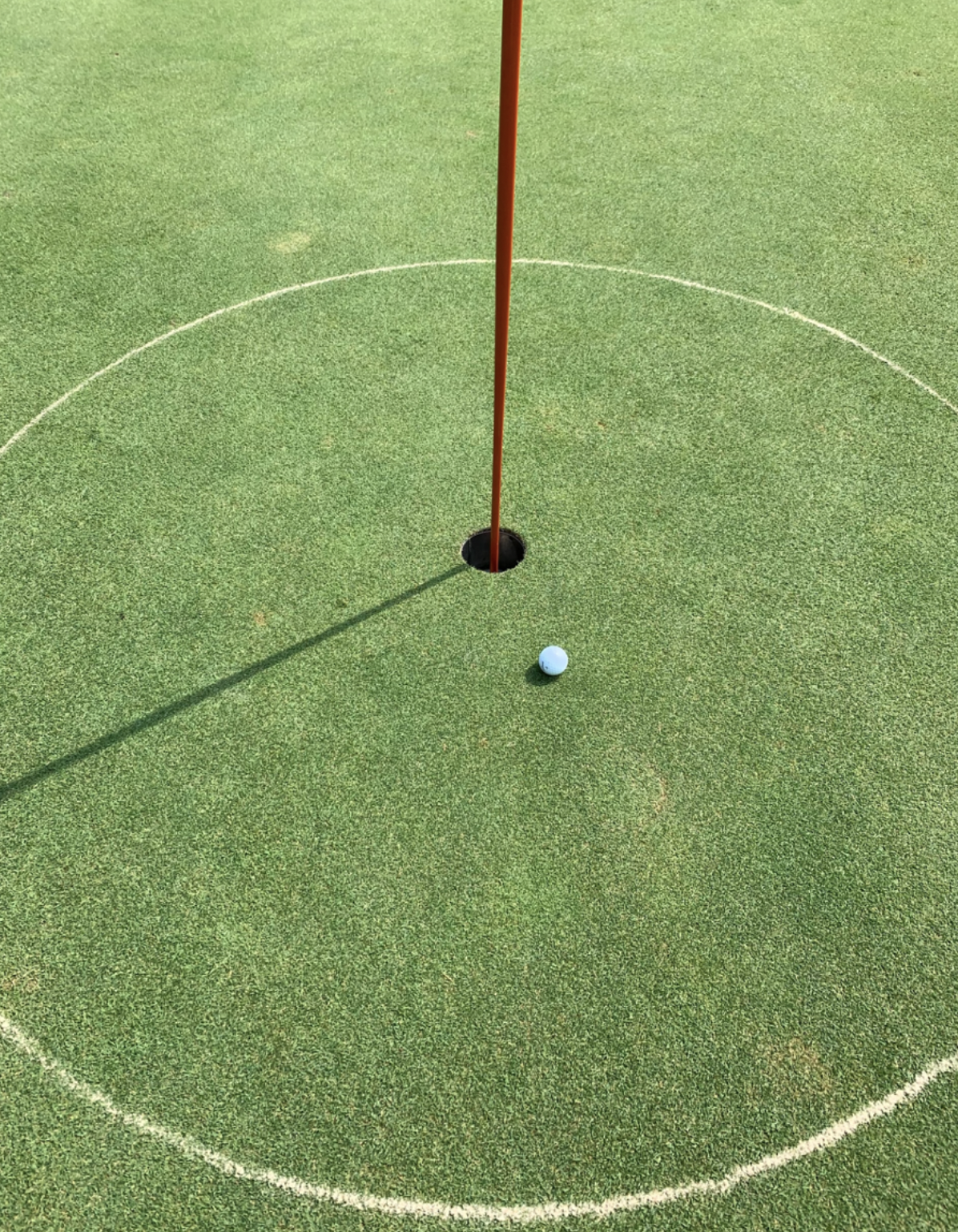
Not gonna lie. These look great with hard breaking downhill putts.
I can’t recall if I’ve ever encountered an actual gimme circle back when growing up in Canada, but more often than not, golfers here will see a circle drawn around the hole cup ranging in radius from 1~1.5m. The obvious intent is that if the ball ends up inside the circle, the next putt is considered a gimme, and the golfer can pick up the ball. At the start of a round, the foursome can decide whether they will put the circle in play or hole out each time.
For the purist, the length of the gimme circle may seem absurd, but I can attest that it does wonders for one’s ego and score, and keeps arguments to a minimum. Of course, it also helps to speed up play.
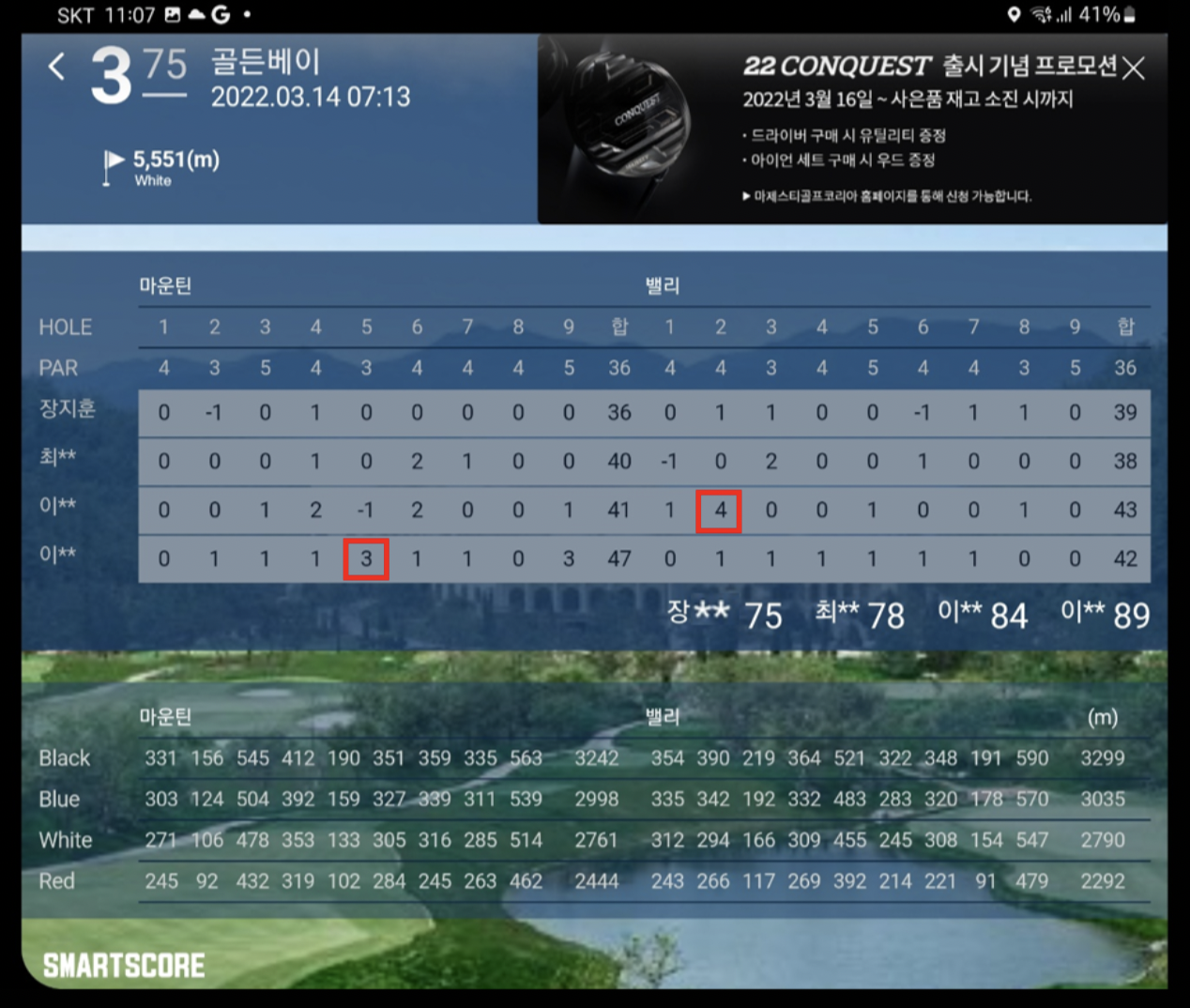
Notice something with the first and last holes too? That’s for another time.
Another aspect of golf that may raise some eyebrows out there is our concept of “double par”. It is common practice here for strokes to be counted only up to double the par of the hole played. For example, the maximum score on a par 3 would be a triple, a quadruple for a par 4, and a quintuple bogey for a par 5.
So even if you were to dunk three balls at the treacherous 17th hole at Sawgrass, the maximum score would be a six (provided that the course was in Korea). Wild stuff, huh? Can you imagine how many pros would love to settle for a triple at that hole during the Players Championship this year?
Again, the main idea for this practice is to speed up play, save some golf balls, and keep one’s handicap comfortably vague for sandbagging purposes.

Carts prevent cardiac arrest.
Last but not least, over 90% of Korea’s public and private courses require golfers to ride a 5-person power cart and employ a caddie with the cost shared among the foursome. What if one doesn't want to ride a cart, or use the services of a caddie?
Unfortunately, it is not a choice at these courses but there are some darn good reasons too.
First, the mountainous topography of Korean courses makes it incredibly hard to walk and play18 holes. The distance between holes can literally be a mile over incredibly steep hills or winding paths down a side of a mountain. So unless you are training for the Iron Man triathlon, there is no shame in riding the cart here. Even for a professional tournament, I understand that special measures are taken to protect the players and caddies in case such a course is played.
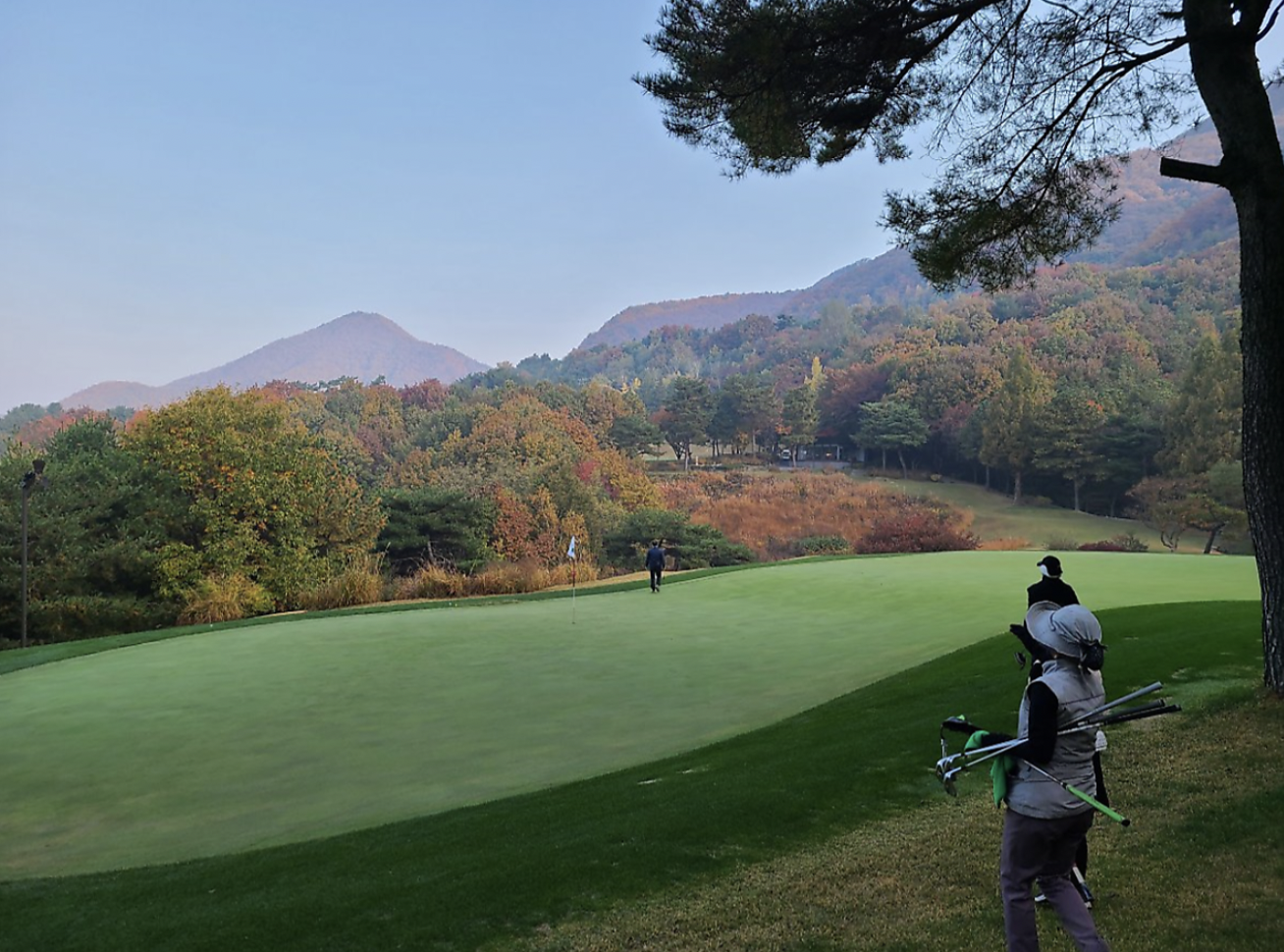
Super caddie in action. Not only does she memorize who uses which clubs and wedges for what
shots, she carries up to 12 clubs at a time for your convenience. Bravo.
Caddies also play a pivotal role in Korean golf culture. Usually, a lone caddie is assigned to a foursome at the start of the round. They driving the cart, cleaning and fetching clubs for all four players, explaining the layout and potential dangers at each hole, and providing yardages, and reading the greens.
It is not an easy task to say the least, but that’s not nearly all. The caddies are also responsible for the safety of the golfers while on the course, and to ensure that the pace of play is maintained in a polite and professional manner (I’m sure they were the most ecstatic when the rule to tend the pin was eliminated). Without a doubt, the caddies here are the true unsung heroes behind the recent growth spurt of golf in Korea. If it were not for them, I know that most of us would be either lost on course
or stuck behind first-timers struggling to play 18 under 6-hours. They deserve every penny they earn.
So there you have it. If speeding up play really helps to grow the game of golf, then the local rules that I have described above will definitely make a difference.
Which one would you be willing to try? Which ones will you fight to your dying breath as a golfer? Please comment below!
For a detailed look at a round of Korean style golf, check out my previous article: “A typical day of Korean golf, Gangnam style”
- LIKE94
- LEGIT3
- WOW8
- LOL3
- IDHT0
- FLOP1
- OB1
- SHANK4
19th Hole
Vincenzi’s 2024 Zurich Classic of New Orleans betting preview

The PGA TOUR heads to New Orleans to play the 2023 Zurich Classic of New Orleans. In a welcome change from the usual stroke play, the Zurich Classic is a team event. On Thursday and Saturday, the teams play best ball, and on Friday and Sunday the teams play alternate shot.
TPC Louisiana is a par 72 that measures 7,425 yards. The course features some short par 4s and plenty of water and bunkers, which makes for a lot of exciting risk/reward scenarios for competitors. Pete Dye designed the course in 2004 specifically for the Zurich Classic, although the event didn’t make its debut until 2007 because of Hurricane Katrina.
Coming off of the Masters and a signature event in consecutive weeks, the field this week is a step down, and understandably so. Many of the world’s top players will be using this time to rest after a busy stretch.
However, there are some interesting teams this season with some stars making surprise appearances in the team event. Some notable teams include Patrick Cantlay and Xander Schauffele, Rory McIlroy and Shane Lowry, Collin Morikawa and Kurt Kitayama, Will Zalatoris and Sahith Theegala as well as a few Canadian teams, Nick Taylor and Adam Hadwin and Taylor Pendrith and Corey Conners.
Past Winners at TPC Louisiana
- 2023: Riley/Hardy (-30)
- 2022: Cantlay/Schauffele (-29)
- 2021: Leishman/Smith (-20)
- 2019: Palmer/Rahm (-26)
- 2018: Horschel/Piercy (-22)
- 2017: Blixt/Smith (-27)
2024 Zurich Classic of New Orleans Picks
Tom Hoge/Maverick McNealy +2500 (DraftKings)
Tom Hoge is coming off of a solid T18 finish at the RBC Heritage and finished T13 at last year’s Zurich Classic alongside Harris English.
This season, Hoge is having one of his best years on Tour in terms of Strokes Gained: Approach. In his last 24 rounds, the only player to top him on the category is Scottie Scheffler. Hoge has been solid on Pete Dye designs, ranking 28th in the field over his past 36 rounds.
McNealy is also having a solid season. He’s finished T6 at the Waste Management Phoenix Open and T9 at the PLAYERS Championship. He recently started working with world renowned swing coach, Butch Harmon, and its seemingly paid dividends in 2024.
Keith Mitchell/Joel Dahmen +4000 (DraftKings)
Keith Mitchell is having a fantastic season, finishing in the top-20 of five of his past seven starts on Tour. Most recently, Mitchell finished T14 at the Valero Texas Open and gained a whopping 6.0 strokes off the tee. He finished 6th at last year’s Zurich Classic.
Joel Dahmen is having a resurgent year and has been dialed in with his irons. He also has a T11 finish at the PLAYERS Championship at TPC Sawgrass which is another Pete Dye track. With Mitchell’s length and Dahmen’s ability to put it close with his short irons, the Mitchell/Dahmen combination will be dangerous this week.
Taylor Moore/Matt NeSmith +6500 (DraftKings)
Taylor Moore has quickly developed into one of the more consistent players on Tour. He’s finished in the top-20 in three of his past four starts, including a very impressive showing at The Masters, finishing T20. He’s also finished T4 at this event in consecutive seasons alongside Matt NeSmith.
NeSmith isn’t having a great 2024, but has seemed to elevate his game in this format. He finished T26 at Pete Dye’s TPC Sawgrass, which gives the 30-year-old something to build off of. NeSmith is also a great putter on Bermudagrass, which could help elevate Moore’s ball striking prowess.
- LIKE8
- LEGIT3
- WOW1
- LOL1
- IDHT0
- FLOP3
- OB1
- SHANK2
19th Hole
Vincenzi’s 2024 LIV Adelaide betting preview: Cam Smith ready for big week down under

After having four of the top twelve players on the leaderboard at The Masters, LIV Golf is set for their fifth event of the season: LIV Adelaide.
For both LIV fans and golf fans in Australia, LIV Adelaide is one of the most anticipated events of the year. With 35,000 people expected to attend each day of the tournament, the Grange Golf Club will be crawling with fans who are passionate about the sport of golf. The 12th hole, better known as “the watering hole”, is sure to have the rowdiest of the fans cheering after a long day of drinking some Leishman Lager.
The Grange Golf Club is a par-72 that measures 6,946 yards. The course features minimal resistance, as golfers went extremely low last season. In 2023, Talor Gooch shot consecutive rounds of 62 on Thursday and Friday, giving himself a gigantic cushion heading into championship Sunday. Things got tight for a while, but in the end, the Oklahoma State product was able to hold off The Crushers’ Anirban Lahiri for a three-shot victory.
The Four Aces won the team competition with the Range Goats finishing second.
*All Images Courtesy of LIV Golf*
Past Winners at LIV Adelaide
- 2023: Talor Gooch (-19)
Stat Leaders Through LIV Miami
Green in Regulation
- Richard Bland
- Jon Rahm
- Paul Casey
Fairways Hit
- Abraham Ancer
- Graeme McDowell
- Henrik Stenson
Driving Distance
- Bryson DeChambeau
- Joaquin Niemann
- Dean Burmester
Putting
- Cameron Smith
- Louis Oosthuizen
- Matt Jones
2024 LIV Adelaide Picks
Cameron Smith +1400 (DraftKings)
When I pulled up the odds for LIV Adelaide, I was more than a little surprised to see multiple golfers listed ahead of Cameron Smith on the betting board. A few starts ago, Cam finished runner-up at LIV Hong Kong, which is a golf course that absolutely suits his eye. Augusta National in another course that Smith could roll out of bed and finish in the top-ten at, and he did so two weeks ago at The Masters, finishing T6.
At Augusta, he gained strokes on the field on approach, off the tee (slightly), and of course, around the green and putting. Smith able to get in the mix at a major championship despite coming into the week feeling under the weather tells me that his game is once again rounding into form.
The Grange Golf Club is another course that undoubtedly suits the Australian. Smith is obviously incredibly comfortable playing in front of the Aussie faithful and has won three Australian PGA Championship’s. The course is very short and will allow Smith to play conservative off the tee, mitigating his most glaring weakness. With birdies available all over the golf course, there’s a chance the event turns into a putting contest, and there’s no one on the planet I’d rather have in one of those than Cam Smith.

Louis Oosthuizen +2200 (DraftKings)
Louis Oosthuizen has simply been one of the best players on LIV in the 2024 seas0n. The South African has finished in the top-10 on the LIV leaderboard in three of his five starts, with his best coming in Jeddah, where he finished T2. Perhaps more impressively, Oosthuizen finished T7 at LIV Miami, which took place at Doral’s “Blue Monster”, an absolutely massive golf course. Given that Louis is on the shorter side in terms of distance off the tee, his ability to play well in Miami shows how dialed he is with the irons this season.
In addition to the LIV finishes, Oosthuizen won back-to-back starts on the DP World Tour in December at the Alfred Dunhill Championship and the Mauritus Open. He also finished runner-up at the end of February in the International Series Oman. The 41-year-old has been one of the most consistent performers of 2024, regardless of tour.
For the season, Louis ranks 4th on LIV in birdies made, T9 in fairways hit and first in putting. He ranks 32nd in driving distance, but that won’t be an issue at this short course. Last season, he finished T11 at the event, but was in decent position going into the final round but fell back after shooting 70 while the rest of the field went low. This season, Oosthuizen comes into the event in peak form, and the course should be a perfect fit for his smooth swing and hot putter this week.

- LIKE12
- LEGIT3
- WOW1
- LOL1
- IDHT0
- FLOP1
- OB1
- SHANK1
Opinion & Analysis
The Wedge Guy: What really makes a wedge work? Part 1

Of all the clubs in our bags, wedges are almost always the simplest in construction and, therefore, the easiest to analyze what might make one work differently from another if you know what to look for.
Wedges are a lot less mysterious than drivers, of course, as the major brands are working with a lot of “pixie dust” inside these modern marvels. That’s carrying over more to irons now, with so many new models featuring internal multi-material technologies, and almost all of them having a “badge” or insert in the back to allow more complex graphics while hiding the actual distribution of mass.
But when it comes to wedges, most on the market today are still single pieces of molded steel, either cast or forged into that shape. So, if you look closely at where the mass is distributed, it’s pretty clear how that wedge is going to perform.
To start, because of their wider soles, the majority of the mass of almost any wedge is along the bottom third of the clubhead. So, the best wedge shots are always those hit between the 2nd and 5th grooves so that more mass is directly behind that impact. Elite tour professionals practice incessantly to learn to do that consistently, wearing out a spot about the size of a penny right there. If impact moves higher than that, the face is dramatically thinner, so smash factor is compromised significantly, which reduces the overall distance the ball will fly.
Every one of us, tour players included, knows that maddening shot that we feel a bit high on the face and it doesn’t go anywhere, it’s not your fault.
If your wedges show a wear pattern the size of a silver dollar, and centered above the 3rd or 4th groove, you are not getting anywhere near the same performance from shot to shot. Robot testing proves impact even two to three grooves higher in the face can cause distance loss of up to 35 to 55 feet with modern ‘tour design’ wedges.
In addition, as impact moves above the center of mass, the golf club principle of gear effect causes the ball to fly higher with less spin. Think of modern drivers for a minute. The “holy grail” of driving is high launch and low spin, and the driver engineers are pulling out all stops to get the mass as low in the clubhead as possible to optimize this combination.
Where is all the mass in your wedges? Low. So, disregarding the higher lofts, wedges “want” to launch the ball high with low spin – exactly the opposite of what good wedge play requires penetrating ball flight with high spin.
While almost all major brand wedges have begun putting a tiny bit more thickness in the top portion of the clubhead, conventional and modern ‘tour design’ wedges perform pretty much like they always have. Elite players learn to hit those crisp, spinny penetrating wedge shots by spending lots of practice time learning to consistently make contact low in the face.
So, what about grooves and face texture?
Grooves on any club can only do so much, and no one has any material advantage here. The USGA tightly defines what we manufacturers can do with grooves and face texture, and modern manufacturing techniques allow all of us to push those limits ever closer. And we all do. End of story.
Then there’s the topic of bounce and grinds, the most complex and confusing part of the wedge formula. Many top brands offer a complex array of sole configurations, all of them admittedly specialized to a particular kind of lie or turf conditions, and/or a particular divot pattern.
But if you don’t play the same turf all the time, and make the same size divot on every swing, how would you ever figure this out?
The only way is to take any wedge you are considering and play it a few rounds, hitting all the shots you face and observing the results. There’s simply no other way.
So, hopefully this will inspire a lively conversation in our comments section, and I’ll chime in to answer any questions you might have.
And next week, I’ll dive into the rest of the wedge formula. Yes, shafts, grips and specifications are essential, too.
- LIKE34
- LEGIT7
- WOW1
- LOL1
- IDHT2
- FLOP3
- OB1
- SHANK3
-

 19th Hole2 weeks ago
19th Hole2 weeks agoDave Portnoy places monstrous outright bet for the 2024 Masters
-

 19th Hole4 days ago
19th Hole4 days agoJustin Thomas on the equipment choice of Scottie Scheffler that he thinks is ‘weird’
-

 19th Hole2 weeks ago
19th Hole2 weeks agoTiger Woods arrives at 2024 Masters equipped with a putter that may surprise you
-

 19th Hole4 days ago
19th Hole4 days ago‘Absolutely crazy’ – Major champ lays into Patrick Cantlay over his decision on final hole of RBC Heritage
-

 19th Hole2 weeks ago
19th Hole2 weeks agoTwo star names reportedly blanked Jon Rahm all week at the Masters
-

 19th Hole1 week ago
19th Hole1 week agoReport: LIV Golf identifies latest star name they hope to sign to breakaway tour
-

 19th Hole2 weeks ago
19th Hole2 weeks agoNeal Shipley presser ends in awkward fashion after reporter claims Tiger handed him note on 8th fairway
-

 19th Hole1 week ago
19th Hole1 week agoBrandel Chamblee has ‘no doubt’ who started the McIlroy/LIV rumor and why











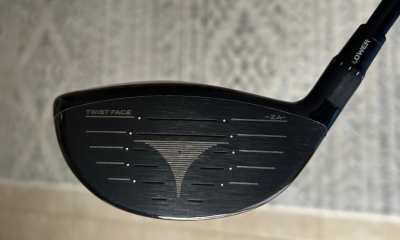

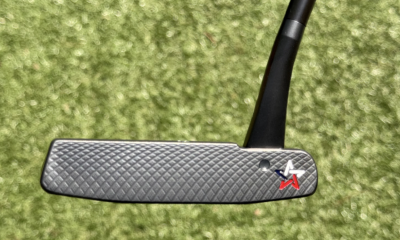










Daddygreen
Apr 24, 2022 at 5:28 pm
Grow the game=make more money. That’s all you care about…even if it’s watered down.
L
Apr 22, 2022 at 3:54 pm
Keep that game there, don’t let them export to the rest of the world. Gimme circle? Ridiculous. Can’t walk in a reasonable amount of time? Don’t build courses there. Sheesh
JL
Apr 22, 2022 at 3:52 pm
Everything at the Korean golf courses were copied from Japan, practically. Same mountain terrains, multi-person cart. Wicked OBs and tight fairways. The gimme circle was tested but scrapped because people wanted to get better at actually playing than be given something. Though it’s a great idea for pace of play, especially when the greens have wicked slopes and can lead to multiple putts, but people need to be allowed to play the game too.
Growing the game? Not like this, just to pump people out there with quick pace just so that the club and industry can make money? No way! Ridiculous.
But yeah accuracy of your shots is important and should be encouraged. lol
geohogan
Apr 21, 2022 at 12:36 pm
If these are the types of golf courses Korean pros grew up playing, then
maybe this help explains oeverwhelming dominance /success on the LPGA tour.
blackbd
Apr 20, 2022 at 2:53 pm
I found this article interesting but not sure if the author is trying to address the distance debate, speed of play or growing the game or all 3? I presume all 3 but not sure how it was all tied together? Also, that kind of super narrow and penal golf seems not fun. Not even sure I want to watch pros play that style other than once or twice a year.
CrashTestDummy
Apr 20, 2022 at 10:25 am
Interesting article. It always interests me how other countries play golf differently. I have played a few times in Asia before and the experience is totally different than the US.
From what I have seen, Korean golf courses look very tough and narrow. I watch a lot of Korean golf shows and you can tell the good player’s ball striking is very accurate, but you have to in order to score on Korean courses. Not like most of the “grip it and rip” it type courses in the US. The gimme circle makes up a little for the toughness of the courses. But definitely not enough. Lol.
neil
Apr 20, 2022 at 12:31 pm
lived in Korea 4 years
weather is great at least for a scotsman.basically 2 seasons warm and cold
Can be 40f one day 70 or higher the next until November then cold again..
we played through the winter down south near Busan.cold but comfortable miles better than a scottish winter
DaeGunn
Apr 20, 2022 at 10:10 am
Golf becomes No.1 sport in Korea. People in general can actually play (not just watch) and enjoy golf, compared with other watching-only sports. Fast growing golf related businesses in Korea may affect the acquisition of big name golf companies by Korean related funds or companies.
As a Korean-American, I heard a lot about Korean’s unique golf course settings nicely summarized in this article. At first, I thought those are very absurd. But as this article explained, I now understand that those are understandable and necessary.
It would be good to know each region’s or country’s different or unique golf cultures.
JungleJimbo
Apr 20, 2022 at 9:28 am
Hi James Chang: Thank you, for your Fabulously-written article that i enjoyed immensely! The Korean approach to golf is intriguing, and GolfWRX is all the better for your series of articles (and unique, i.e. i don’t see this Korean perspective on many other mainstream golf publications). “?????”!
Jub
Apr 20, 2022 at 8:55 am
No! Stop growing the game!
MhtLion
Apr 20, 2022 at 12:51 pm
That’s what I’m saying.
Garrett
Apr 22, 2022 at 12:48 pm
Im with you on that. not enough golf courses or CC around me to even get decent times. STOP GROWING THE GAME
Rascal
Apr 22, 2022 at 1:49 pm
Me! Me! Me!!!!
Waaaaaahh!